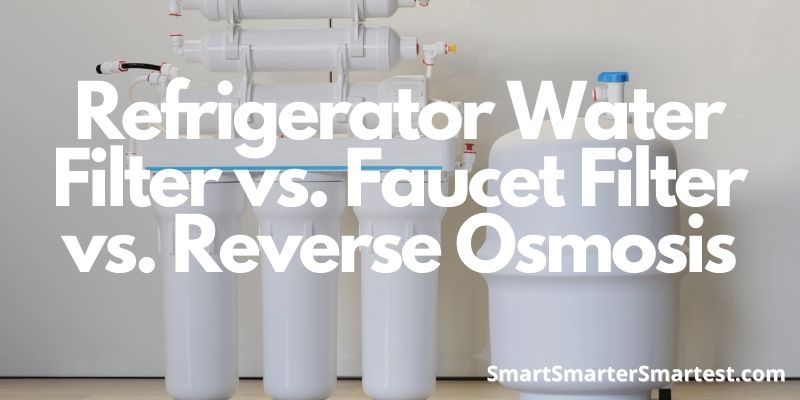If you are uncertain as to what separates refrigerator water filters, faucet filters, and reverse osmosis filters from one another, you’re at the right place! By reading this guide, you will learn all about these three filters and what they do. That way, you can determine which filter is ideal for your needs.

What Does A Refrigerator Water Filter Do?
A refrigerator water filter is a water filter that can be found in, as the name implies, a refrigerator. Most refrigerator water filters are quite simple and basic, and that’s because they aren’t designed to perform any especially intensive filtration. But, they are very good at removing certain contaminants – usually the larger – ones which are very useful.
To filter your water, a refrigerator water filter uses granules of activated carbon. As water flows through these granules of activated carbon, large contaminants – chlorine being a good example – are removed. By the end of the filtration process, the largest contaminants in the water are completely removed, which ensures that they are fairly clean.
Since refrigerator water filters only rely on activated carbon granules, they aren’t as effective as other water filters. By using a refrigerator water filter, you can remove many of the larger contaminants that are within your water, but you can’t remove bacteria, viruses, minerals, or metals. Because of that, if you live in a place where the tap water frequently has those materials, then a refrigerator water filter may not be sufficient.
What Does A Faucet Filter Do?
A faucet filter is, as the name indicates, a filter that can be installed to a faucet. Right after a faucet filter has been installed to a faucet, you can turn on that faucet and all of the water flowing through that faucet will flow through the faucet filter. When the water is done flowing through the faucet filter, it will come out of either the main tap or a separate filtration system.
More often than not, faucet filters rely on a basic, but sophisticated, system of filtration. The system begins with a small net that water must flow through. By flowing through this net, larger particles – dirt, for example – are blocked from moving any further. That way, the water you drink doesn’t have any dirt in it, or any other large particles.
Right after the water flows through that net, it flows through a system that consists of compressed blocks of carbon and zeolite. Both of these materials are used to remove contaminants such as chlorine. Then, right after the water is finished flowing through those two systems, it comes out of the faucet.
Most faucet filters aren’t that much more effective than refrigerator water filters. But, they do offer better sediment removal – due to the small net that traps those larger particles – and they tend to be a little more thorough than refrigerator water filters.
While most faucet filters are quite simple, there are a few that offer more elaborate filtration systems. Filtration systems that allow for metals, viruses, and bacteria to be removed. But, these faucet filters tend to be far more expensive than standard water filters.
What Does A Reverse Osmosis Filter Do?
Reverse osmosis filters are, in comparison to the two previous filters, exceptionally powerful. All of this power comes from the fact that reverse osmosis filters rely on complex, but thorough, filtration systems that remove all of the contaminants within the water. When the reverse osmosis process is finished, the water is as clean as it can be, ensuring that it’s extremely safe to drink.
The reverse osmosis process consists of four steps. Water first flows through a net – which serves as a sediment filter – that removes dirt, salt, and sand – among others particles. Right after that, water flows through a carbon filter, which removes larger contaminants – chlorine, for example – and eliminates any strange smells or tastes. Then, water flows through a semipermeable membrane, which is used to remove any of the remaining contaminants. To end the process, water then flows through one last activated carbon filter, which removes whatever contaminants are left over.
By using a reverse osmosis filter, a variety of different contaminants are effortlessly removed. Contaminants such as lead, chlorine, iron, mercury, fluoride- and many others. Since reverse osmosis filters are capable of removing so much, they are some of the most powerful filters available.
Conclusion
In the end, all three water filters are excellent and serve their purpose very well. For a basic, but effective, filter, you can’t go wrong with a refrigerator or faucet filter. But, if you want the best of the best, then a reverse osmosis filter is the ideal choice!